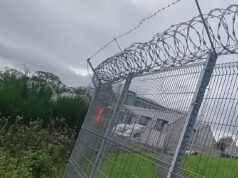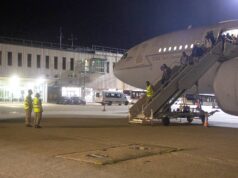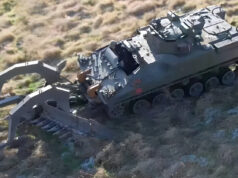The Ministry of Defence (MOD) spent £28.8 billion with UK industry and commerce during the 2023/24 financial year, marking an 8% increase compared to the previous year when adjusted for inflation, according to newly released statistics.
Spending across UK regions saw significant growth, with the East Midlands experiencing a 30% rise, the largest percentage increase.
This was driven by increased contracts with Rolls-Royce at its Derby Raynesway site. In total, defence expenditure in the East Midlands reached £1.4 billion, the region’s highest figure since 2013/14.
Northern Ireland also recorded a substantial rise of 20%, attributed primarily to spending with Thales UK Limited for assembling Next Generation Light Anti-Tank Weapon (NLAW) systems.
Yorkshire and the Humber and the North West followed closely, with expenditures rising by 19% and 18%, respectively.
The MOD’s report highlighted that the South East (£7.1 billion) and South West (£6.9 billion) remained the top regions for defence spending, followed by the North West (£3.83 billion).
Per Capita Spending
The MOD spent an average of £420 per person in the UK, the highest figure in over a decade. This represents an increase of £30 from the previous year. Regional disparities were evident, with the South West leading at £1,190 per person, followed by the South East.
The East Midlands saw the most significant rise in per capita spending, up 32% to £290, while Yorkshire and the Humber rose by 22% to £110 per person.
Key Industrial Investments
The MOD’s expenditure in the Technical, Financial, and Other Business Services sector reached £8.7 billion, a 34% increase compared to the previous year.
This growth equated to an additional £2.2 billion, highlighting the importance of technical services within the defence economy.
Small and Medium-sized Enterprises (SMEs) received £1.3 billion, equating to 4% of the MOD’s direct expenditure. Furthermore, 84% of the MOD’s global spending remained within the UK, including contracts facilitated through Foreign Military Sales agreements with the US.
These figures underscore the MOD’s significant role in supporting the UK economy. The Defence Ministry noted: “Increased MOD spending with UK industry has driven rises in defence expenditure per person living in the UK.”
While the South East and South West maintain their positions as primary beneficiaries, the growth in regions like the East Midlands and Northern Ireland reflects the MOD’s ongoing efforts to distribute economic benefits across the UK.
The report highlights how defence spending contributes not only to national security but also to regional economies.
At the UK Defence Journal, we aim to deliver accurate and timely news on defence matters. We rely on the support of readers like you to maintain our independence and high-quality journalism. Please consider making a one-off donation to help us continue our work. Click here to donate. Thank you for your support!













And once again, the Northern Ireland, the North East and Yorkshire vie with each other for least Defence investment, as they do every year. With the North East losing out in total investment, Yorkshire took pride of last place again on investment per person. Everything is relative, and the per person investment ratio between the South West and Yorkshire is only around 11-fold, whereas in 2019 it was 25-fold. So that’s something. The %age rises mentioned in the article came from a very low base. Scotland, which has typically done better than the UK as a whole in recent years, has done worse per person. There’ll be noises made about that. Not highlighted in this article though; not written by George.
We have a need to create new industries in categories such as drones, ammunition and explosives manufacture, gun barrels, etc. It will be interesting to see how much investment goes into the three defence-pauper regions to fulfil a levelling up agenda that have been perennially ignored or in the case of a certain Northern Irish shipyard, sabotaged. I believe RBSL already has something in the NE so maybe the gun-barrel requirement will get fulfilled there.
Doubt it will be in the NE, more likely Sheffield as that’s were the billets will be forged and I believe they also have mothballed machinery and very transferable skills. It’s sad but it’s way easier to re start production of heavy barrels where you have a related industry. RBSL does have a presence in Gateshead, but it’s also very easy to overlook their sub contractor on Tyneside. Pearsons who build major parts for them in the Old Armstrong works, interestingly they are now part of Rafael Group who have bought the site outright. So they are expanding !
Agree around Sheffield, I do think that would be a good thing to be honest.
Especially as Yorkshire has exactly the same population as the whole of Scotland. I would say this as being from Sheffield, but there’s a lot of engineering and steel capabilities here.
But given statistic are usually reporting historically and from months before this was mostly in place before the current government took office. But we can expect a rise in domestic spending on defence, the increase in employer NI guarantees this although it adds zero capability 🙁
We need to focus just as much on what is delivered as what is spent, it fairly easy for government past a present to spend more with out seeing any increase in capabilities or even make cuts whilst spending more.
So of that £28.8 billion, I wonder what percentage of that is waste, as in inefficiency, ‘gold plating’, backhanders, fraud, theft, being overcharged, divisive contracts and ludicrous outsourcing?
Not as much as popular culture would have you believe.
Most waste is driven by endless change and as you say gold plating of specs!
Changes and central control issues go hand in hand with a lot of wasted time and money.
I would be interested to hear examples of gold plating of specs! It is often talked about but rarely demonstrated.
A key point is that with very small armed forces they need to have highly capable equipment to compensate for sparse numbers. Can a British tank, fighter or ship ever really be too good for the job?
Is the East Midlands increase (mainly at RR) MoD investment or Australian AUKUS investment being co-opted by the MoD ?
I don’t think the numbers can include foreign investment as the MOD budget hasn’t risen to include Aussie cash, so claiming that they spent it would be difficult.